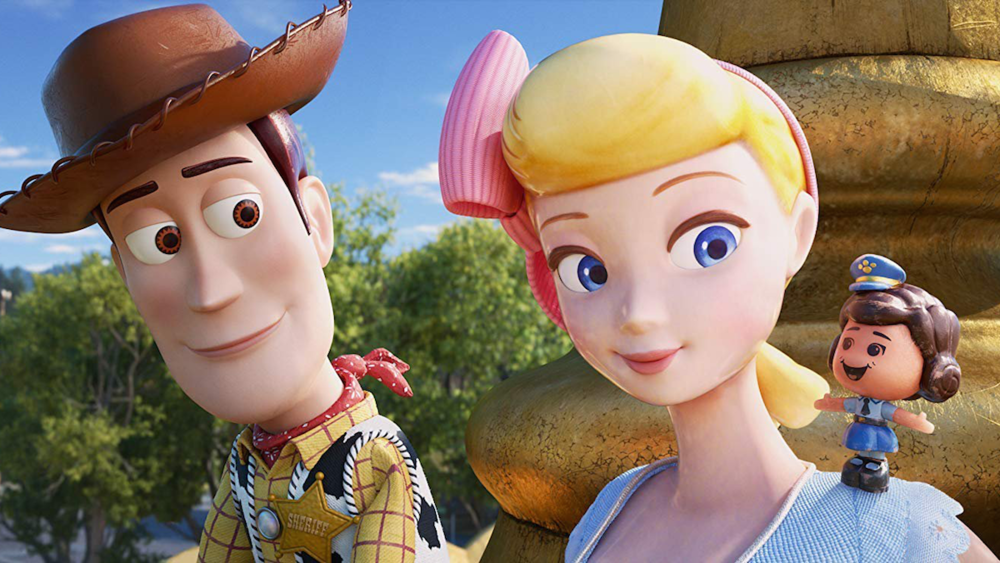
(Image: nerdist.com)
TOY STORY 4-- 2 STARS
It could be the first movie, fourth movie, or the 17th of something really extensive, a beneficial purpose needs to be present beyond the business end of selling tickets and what not. For each movie or chapter at hand, one has to consider if there is a worthwhile story to tell, one that can justify this new effort being a true necessity. The key word there is worthwhile. To more specifically judge a sequel in that regard, one has to look where it came from and where it is going. Toy Story 4 indeed attempts to advance characters and chooses trajectories, but then look backward and forward and ask about value and placement. Despite the immense talent shining from the recording studio and the animation workshop, the traits and choices of Toy Story 4 lack being worthwhile.
LESSON #1: THE SYNONYMS OF “WORTHWHILE”-- Dissect this important adjective further with its synonyms that offer a range of its possible connotations as a description. This review will feature five from worthwhile’s Thesaurus.com entry: advantageous, beneficial, constructive, justifiable, and valuable. All five can be applied to this film.
Advantageous and valuable, in the lucrative sense, are easy because the braintrust of Pixar has been tempted for the better part of a decade to re-open Toy Story after many initially ruled it out following the excellence of Toy Story 3. Audience interest and earning potential has not faded where this was bound to happen at some point. Now it’s here and it’s about earning justifiable inclusion and existence.
A few years have passed since our core corps of toys were passed on to hazel-green-eyed Bonnie from the college-bound Andy. The toddler is now an anxious little girl entering kindergarten after starting to show favor at home towards other playtime favorites than our stalwart cowboy Woody (Tom Hanks). Even on the dust bunny closet sidelines, the vocal sheriff and leader still sees Bonnie’s happiness as his chief duty. He sneaks into Bonnie’s backpack for orientation day to be a familiar face and watches her having no luck in making friends or feeling positive.
Scavenging and sneaking some scraps and art supplies to Bonnie, Woody watches her create a makeshift little character out of a spork, pipe cleaner, stick-on shaky eyes, and other craft materials. With connection and accomplishment, Bonnie names him Forky and the sprinkle of loveable alchemy that makes Forky a toy to her brings him to life. The little junker (Tony Hale) becomes Bonnie’s favorite comfort but sentiently believes he’s still trash, a transition of character growth that will come from Woody’s teaching and leadership since the days of Buzz Lightyear (Tim Allen).
LESSON #2: INTERPRET YOUR INNER VOICE-- The first of many possible takeaway chestnuts for the target demographic showing up in droves for this movie is a message on conscience. Various characters in the movie, between pull-strings and heartstrings, duel with literal and figurative forms of their inner voice and how best to follow it or not. Good, bad, and questionable choices are made across the board for younger audiences to see as cautionary examples. This lesson counts as mildly beneficial in the worthwhile department.
All this built-up confidence and protection for Bonnie falls into peril when Forky gets lost on a family road trip to end the summer. Woody goes after him while Buzz (Tim Allen), Jessie (Joan Cusack) and the others hold down the family RV and stall Bonnie’s parents. Woody and Forky become sidetracked by the reemergence of his old flame Bo Peep (Annie Potts) who has found a thriving new life as a “lost” toy living independently on her own. Their reunion and pursuit intersects with the forgotten toys of an antique store led by Gabby Gabby (Christina Hendricks), an unwanted pull-string doll with a broken voice box and a gang of extremely creepy slick-haired suits at her disposal, who have taken Forky captive.
LESSON #3: BEING LOST VERSUS BEING FREE-- In unison with Lesson #2, Disney has always had a tendency to over-highlight their chosen morals and themes. The “lost” fear here in Toy Story 4 is the first of two teachable concepts and plot ingredients that are beaten to death, even by Mouse House standards. Much fluster and bluster is expressed for avoiding becoming lost, helping the lost, and/or getting over something lost. All the while, and very true to the human condition paralleled through these cherished toys, there is a potential sunny freedom possible in being unbound that seeps in clouding motivations and futures. Still, it’s an overplayed point.
Circle back to purpose. The first Toy Story was groundbreaking and its stellar sequel strengthened and expanded its world-building beautifully. The keenly nostalgic third film wisely and perfectly brought everyone and everything further to a mature, impactful, and fitting conclusion. Continuing a journey that had an ending for a questionable transition such as this, Toy Story 4 does not match or exceed where it came from, not when repetitiveness and disconnection reign.
Eight creators, ranging from departed Pixar chief John Lasseter to the clever Celeste and Jesse Forever writing team of Rashida Jones and Will McCormack, are credited with this hodgepodge story ineffectively narrowed by the credited screenwriters of Pixar vet Andrew Stanton and new voice first-timer Stephany Folsom. This feels like eight or more ideas that all distract and tangle each other up to failing points. Because of stature and importance, it is difficult to positively describe the result as constructive. Unnecessary is a very tempting label, one that is probably too strong, but it is very close.
Both within the Toy Story franchise and beyond in other family films, we’ve seen the self-urgent dalliances and pitfalls of a manic need-to-get-back-home adventure endless times now. As the fourth film following what was serene closure, this counts as unjustified and even misguided. Cutely twitchy as he is, Forky is no better than a mini MacGuffin to force action and the mad cap spins become excessive by the time the movie culminates in a rehash Finding Dory’s vehicular takeover action finale. Likewise in the opposite direction, the Gabby Gabby tangent comprising the movie’s meaty middle is long-winded and ineffectual, even with a redemptive ending we can see coming.
The curveballs and new guest characters, ranging from a motorcycle stuntman action figure (Keanu Reeves) and carnival prize pair of stuffed animals (Keegan Michael Key and Jordan Peele) and a few others, are certainly cute thanks to their casting personalities, but paper thin as merely and predominantly additions of comic relief. Even with a semi-exciting pre-credits rescue sequence revealing Bo Peep’s fate between the events of Toy Story 2 and Toy Story 3, the swelling and positive female empowerment of the returning shepherdess that was an afterthought before this movie takes away from the established core on the sidelines like Buzz, Jessie, and more who carry more lasting care. For example, had this been applied to Jessie or if the entire movie was more Toy Story 2.5 instead of a final one unwinding the catharsis of Toy Story 3, this all might have played better for justification and continuance.
Let’s not kid ourselves. Of course, all the talent in the world is here. The movie looks and sounds like a billion bucks. That said, story and purpose matter more than prowess at this point. Throughout this entire series, this has always been about the over-dramatic Woody correcting a personal flaw first and anything else second. His nobility to always be there is incredibly honorable. All arcs lead to him and Toy Story 4 is truly a unique and daring transition point for that character. However, it is elevated, again, at the expense of his partner Buzz and the rest of the toys who once hand-in-hand bonded with shared fates. Tom Hanks can carry that moment, but the punch, the famed “Pixar Punch” this writer and website has long touted and celebrated, misses in a way that may perplex younger children and raise an eyebrow in the escorting adults asking why this matters.
LESSON #4: KNOWING TIMELINESS-- The progression of Woody is what brings the second simplistic and prescriptive nugget over-hammered by Toy Story 4. Implored loudly in some moments and reflecting softly in others, the lament of knowing it’s time, knowing your time, or being ready for either state is overflowing in every direction towards Woody. It’s a high hurdle for the plastic protector and apparently one for the filmmakers themselves too who didn’t know when or how to leave this all be.

LOGO DESIGNED BY MEENTS ILLUSTRATED (#795)
from REVIEW BLOG - Every Movie Has a Lesson http://bit.ly/2wZrJYy







No comments:
Post a Comment